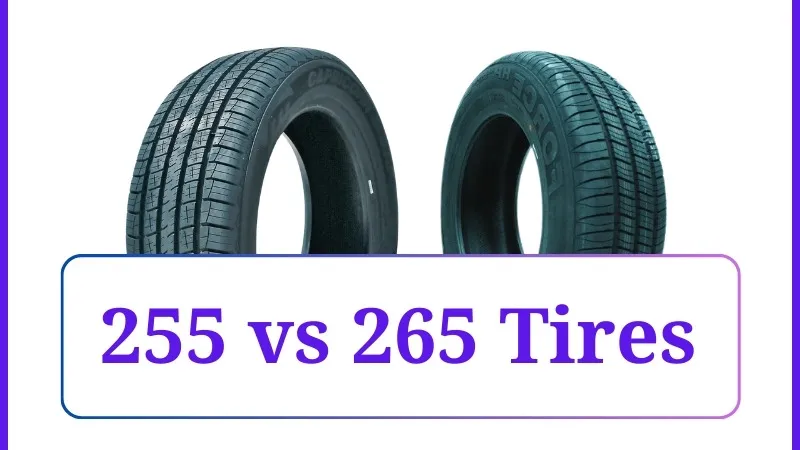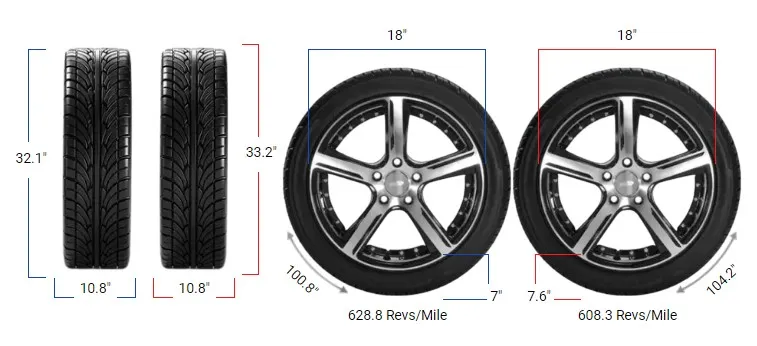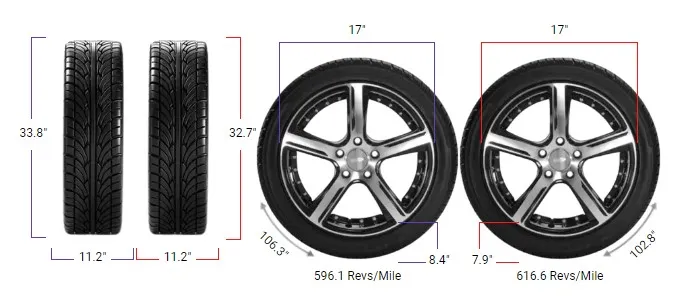255 vs 265 Tires

The primary difference between 255 and 265 tires is their width. The 265 tire is slightly wider, measuring 10 millimeters more than the 255 tire.
This may seem minor, but it can have a noticeable impact on your vehicle’s performance, including its handling, stability, and road grip.
With 265 tires, the wider footprint increases the contact patch, providing better traction and stability. This can be especially useful for drivers looking for improved cornering capabilities or better control on wet roads.
On the other hand, 255 tires are narrower, which reduces rolling resistance, thereby enhancing fuel efficiency and making the vehicle easier to maneuver, particularly in urban settings.

Fitment Guide
Before considering a switch between 255 and 265 tires, it is important to ensure they will fit properly on your vehicle. Below is the Ideal Rim Width Range for each size:
- 255 tire: Suitable for rims that are 8.0 to 9.5 inches wide.
- 265 tire: Fits rims ranging from 8.5 to 10.0 inches wide.
To make a tire swap possible, two conditions must be met:
- Rim Width Compatibility: There needs to be an overlap in the Ideal Rim Width Range for the new tire size. In this case, both 255 and 265 tires can fit rims that are 8.5 to 9.5 inches wide, which means they can be swapped without needing new rims.
- Aspect Ratio and Overall Diameter: The aspect ratio and rim diameter must remain the same, or the overall diameter difference must be within 3% to maintain accuracy in the speedometer and keep vehicle performance optimal. If these conditions are not met, it is not recommended to proceed with the swap.

On-Road Impact
Swapping to a wider tire like the 265 can have several effects on your vehicle’s performance:
- Handling and Stability: The 265 tire’s greater width offers improved traction, which can enhance stability, especially during cornering. This is particularly beneficial for drivers who prioritize a more controlled driving experience.
- Comfort: With the wider contact patch, the 265 tire may provide a smoother ride, but it could also make the steering feel heavier. Depending on your preferences, this could be a pro or a con.
- Fuel Efficiency: Wider tires tend to generate more rolling resistance, which might slightly reduce fuel efficiency compared to narrower options like the 255. This is worth considering if fuel economy is one of your top priorities.

Off-Road Impact
If you’re an off-road enthusiast, the choice between 255 and 265 tires can impact your adventures:
- Traction: The wider 265 tire provides a larger surface area, which can help when driving over loose surfaces such as sand or gravel. This improved grip can be an advantage in off-road situations.
- Mud Performance: Conversely, narrower tires like the 255 may perform better in muddy conditions, as they can dig deeper and find traction more effectively compared to wider tires, which may float on top of the mud.
Pros of Switching to 265 Tires
- Better Traction and Stability: The wider tread offers more grip, which is beneficial for both on-road and off-road driving.
- Enhanced Cornering Performance: Improved contact with the road means better handling, especially when cornering at higher speeds.
- Smoother Ride: The wider tires may provide a softer ride on uneven surfaces, adding to the overall comfort.
Cons of Switching to 265 Tires
- Increased Fuel Consumption: Wider tires generally have greater rolling resistance, which could lead to a slight decrease in fuel efficiency.
- Heavier Steering Feel: The increased width can make steering feel heavier, which may be less comfortable for some drivers.
- Potential Clearance Issues: If the overall diameter is not within the 3% threshold, it could lead to clearance issues with the fender or suspension components.

Pros of Staying with 255 Tires
- Better Fuel Efficiency: The narrower profile means less rolling resistance, which can improve your vehicle’s fuel economy.
- Lighter Steering: A narrower tire can make the steering more responsive, which may be more enjoyable for daily driving.
- Cost-Effective: If your current tires are performing well, staying with the same size can save you the cost of switching and ensure compatibility.
Cons of Staying with 255 Tires
- Less Traction: The narrower tire has a smaller contact patch, which might not provide the same level of traction as a wider tire, particularly in challenging conditions.
- Reduced Stability: Especially noticeable during aggressive cornering or at higher speeds, the 255 tire may not offer the same level of stability as the 265.
Difference Between 255 and 265 Tires
The primary difference between 255 and 265 tires is their width. The 255 tires are 255 millimeters wide, while 265 tires are 265 millimeters wide, making the 265 tires 10 millimeters wider.
Both tire sizes share overlapping ideal rim widths of 8.5, 9.0, and 9.5 inches. When considering a swap, ensure the aspect ratio and rim diameter are the same, or the overall diameter difference is within 3%.

Can I Use 255 Tires Instead of 265?
Yes, you can use 255 tires instead of 265 tires if your rims fall within the overlapping ideal width range of 8.5 to 9.5 inches.
It’s important that the aspect ratio and rim diameter remain the same, or the overall diameter difference is within 3%. This ensures safety, performance, and comfort are maintained when making the switch.
Can I Use 265 Tires Instead of 255?
You can use 265 tires instead of 255 tires if the rims are within the shared ideal width range of 8.5 to 9.5 inches.
Make sure the aspect ratio and rim diameter are identical, or that the overall diameter difference doesn’t exceed 3%. This swap is acceptable and maintains the balance between performance, safety, and comfort.
Can You Put 255 Tires on 265 Rims?
Yes, you can put 255 tires on rims designed for 265 tires if the rim width is between 8.5 and 9.5 inches.
Ensure the aspect ratio and rim diameter of the tires match, or that the overall diameter difference is within 3%. Meeting these conditions makes the tire swap possible and safe.

Can You Put 265 Tires on 255 Rims?
You can install 265 tires on rims used for 255 tires if the rims are between 8.5 and 9.5 inches wide.
It’s crucial that the aspect ratio and rim diameter are the same, or the overall diameter difference is within 3%. This allows for a safe and effective tire swap without compromising performance.
Our Observation
Switching from 255 to 265 tires can be a great option if you’re looking for better traction, improved stability, and a slightly more comfortable ride.
However, it’s important to consider the potential trade-offs, such as a reduction in fuel efficiency and a heavier steering feel.
If you prioritize fuel economy and nimble handling, sticking with 255 tires might be the better choice. Ultimately, both options have their strengths, and the best choice will depend on your driving habits and preferences.
Whether you decide to stay with 255 or switch to 265, make sure to assess your needs and driving conditions to ensure the tire you choose provides the best performance and safety for your vehicle.



